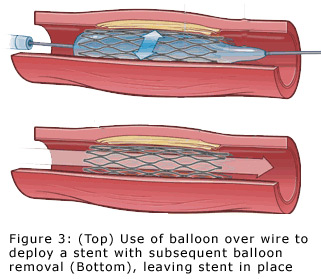Peripheral Stenting is an intervention procedure
performed to either open blockages formed from plaques in peripheral arteries or to stablize severely aneurysmal
(dilated) blood vessels.
BCS Heart
provides services in the areas of carotid stenting, abdominal aortic aneurysm stenting, and upper and lower extremity
stening.
Plaques form as a result of atherosclerosis, an inflammatory process that eventually results in calcium
deposits within the walls of blood vessels. If these plaques become severe enough, impairment in blood flow results.
A similar process can result in severe weakening of blood vessel walls, leading to dilated blood vessels which may
have an increased risk for rupture.
A stenting procedure is commonly performed in patients who have symptoms of peripheral vascular disease (e.g. stroke,
lower extremity pain with walking, non-healing wounds) or patients who are at high risk for an adverse event due to
severe blockage or severe dilation (aneurysm) of a blood vessel.
For more detailed information about the peripheral stenting procedure, continue reading below.

Peripheral stenting, if necessary, is performed when a catheterization procedure demonstrates concerning findings
within a blood vessel.
A long, thin, flexible tube, called a catheter, is typically inserted into the leg or arm through a tiny incision
(less than one-tenth of an inch) at the skin surface. These catheters are used to help position wires within
the abnormal blood vessels.
A balloon, stent, or other equipment may then be advanced over the wire and used to treat the abnormal blood vessel.
In the event that a stent is used, the walls of a peripheral artery will eventually grow around the stent, much like ivy
can grow and eventually cover
a chain-link fence.
While this healing process is occuring, certain medications are extremely important to take and
your physician will discuss this with you. In most instances, aspirin is required life-long, and an additional medication
called clopidogrel or prasugrel may be needed for a period of time, depending on the type of stent and reason for its
placement. Your doctor will discuss with you the specifics regarding necessary medications.
If you recently have had
a peripheral stent and are taking medications prescribed by your cardiologist, do not stop these medications for any
reason without consulting your doctor.

 Peripheral stenting, if necessary, is performed when a catheterization procedure demonstrates concerning findings
within a blood vessel.
A long, thin, flexible tube, called a catheter, is typically inserted into the leg or arm through a tiny incision
(less than one-tenth of an inch) at the skin surface. These catheters are used to help position wires within
the abnormal blood vessels.
Peripheral stenting, if necessary, is performed when a catheterization procedure demonstrates concerning findings
within a blood vessel.
A long, thin, flexible tube, called a catheter, is typically inserted into the leg or arm through a tiny incision
(less than one-tenth of an inch) at the skin surface. These catheters are used to help position wires within
the abnormal blood vessels.